Protecting your Bitcoin and Altcoins should be a priority for anyone who has more than just a few dollars worth of coins. Developers have been working tirelessly since Bitcoin’s inception on how to create secure and safe wallets for users. Many very good software wallets have come out since then, with varying degrees of security versus convenience. However the problem persisted, any computer -or mobile device- infected with Bitcoin-centric malware or keylogging software meant any coins in any wallets on that device were in peril. So the concept of Hardware wallets took off. The Merkle has done some written and video reviews of a few of these in the past, and I recently got my hands on Ledger’s Nano S about about $65 (USD). Let’s review some of its features.
The Device
The Ledger Nano S is a well respected hardware -smartcard- cryptocurrency wallet. The device connects to any computer via a micro USB cable and needs the user to enter their PIN each time they connect the device. This is gives the Nano S an advantage over some other Ledger models, as the PIN is entered on the device so it will be immune to keylogging. The device can also have a auto lock time set on it for an added layer of security. It supports Bitcoin and Ethereum -both Classic and Beta- with integrated and dedicated wallets, but also can support Litecoin, Dash, and (a favorite of mine) Dogecoin via the Bitcoin Wallet app. Ledger Nano S requires that all transactions be confirmed on the actual device. The private keys never leave the device itself, which is why confirmations of sending transactions to take place on the Nano S rather than via a passphrase or PIN in the wallet’s user interface.

The Nano S and its Accessories.
The device itself is stylish, robust, and of good quality. The toggle buttons are responsive and feel well built -they are not sliding around or loose-. Connecting it feels a bit stiff, but the connection is solid then. Recovery and backup of the device is secure as well. Recovery words are issued on the Nano S upon setting it up, and those are stored in an offline and analog way. Any wallet can be restored with these on any other Ledger device or a compatible wallet.
The User Interface and FIDO U2F
The User Interface (UI) for the wallet(s) take place on the screen on any device that has Chrome as a web browser. Simple, elegant, and to the point, these interfaces allow you to receive and send coins while also allowing you to view the transactions on the blockchain -via a link-. The user can also customize their wallets to reflect the local fiat currency, the denomination of the coins (BTC, mBTC, etc), and language. It is extremely user friendly and -dare I say it- rather fun to use.
Ledger Nano S can also be used -should the user care to set this up- as a form of two-step authentication outside of cryptocurrency related business. This is because it supports FIDO Universal Second Factor Authentication (U2F). Essentially with this enabled on the Nano S, authentication with websites, companies, and services which also support FIDO can be done using the Nano S as the smart key component. It would be like signing/confirming a transaction to be sent, but instead the user would be logging into their gmail account.
Overall this is an affordable, secure, and user friendly solution for offline authentication of Bitcoin and Altcoin transactions. I would suggest that anyone who has Bitcoin and can afford to sink just under 70 bucks into better security consider the Nano S, as I am thoroughly enjoying using this device.
If you liked this article, follow us on Twitter @themerklenews and make sure to subscribe to our newsletter to receive the latest bitcoin, cryptocurrency, and technology news.

